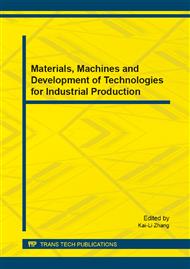[1]
Zhang, J., Zhang, H., Wang, L., Guo, X., Wang, X., & Yao, H. Isolation and identification of antioxidative peptides from rice endosperm protein enzymatic hydrolysate by consecutive chromatography and MALDI-TOF/TOF MS/MS. Food Chemistry, 119(1), 226-234. (2010).
DOI: 10.1016/j.foodchem.2009.06.015
Google Scholar
[2]
Chen, H. M., Muramoto, K., & Yamauchi, F. Structural analysis of antioxidative peptides from Soybean. beta. -Conglycinin. Journal of Agricultural and Food Chemistry, 43(3), 574-578. (1995).
DOI: 10.1021/jf00051a004
Google Scholar
[3]
Mendis, E., Rajapakse, N., & Kim, S. K. Antioxidant properties of a radical-scavenging peptide purified from enzymatically prepared fish skin gelatin hydrolysate. Journal of agricultural and food chemistry, 53(3), 581-587. (2005).
DOI: 10.1021/jf048877v
Google Scholar
[4]
Tsuge, N., Eikawa, Y., Namura, Y., Yamamoto, M., & Sugisawa, K. Antioxidative activity of peptides prepared by enzymic hydrolysis of egg white albumin. Nippon Nogeikagaku Kaishi, 65, 1635–1641. (1991).
DOI: 10.1271/nogeikagaku1924.65.1635
Google Scholar
[5]
Suetsuna, K., Ukeda, H., & Ochi, H. Isolation and characterization of free radical scavenging activities peptides derived from casein. The Journal of Nutritional Biochemistry, 11(3), 128-131. (2000).
DOI: 10.1016/s0955-2863(99)00083-2
Google Scholar
[6]
Jung, W. K., Qian, Z. J., Lee, S. H., Choi, S. Y., Sung, N. J., Byun, H. G., & Kim, S. K. Free radical scavenging activity of a novel antioxidative peptide isolated from in vitro gastrointestinal digests of Mytilus coruscus. Journal of medicinal food, 10(1), 197-202. (2007).
DOI: 10.1089/jmf.2006.101
Google Scholar
[7]
Tang, X., He, Z., Dai, Y., Xiong, Y. L., Xie, M., & Chen, J. Peptide fractionation and free radical scavenging activity of zein hydrolysate. Journal of agricultural and food chemistry, 58(1), 587-593. (2009).
DOI: 10.1021/jf9028656
Google Scholar
[8]
Liu, E.,Q., He, J. P., Chen, Z.J., Liu, H.P., & Li, Y.E. Antioxidation activity in vitro of enzymic hydrolysates from black soybean. Journal of Chinese Cereals and Oils Association, 24(11): 38-41, (2009).
Google Scholar
[9]
Zhao, X.H., & Fong, Z.B. A study on the determination of the degree of hydrolysis in soy protein hydrolysates. Journal of Northeast Agricultural University, 26, 178-181. (1995).
Google Scholar
[10]
Li, H., Liu, E.Q., Tang, S. R., & Wu, Y. H. Enzymatic preparation, purification and amino acid composition of antioxidant peptides from black soybeans. Food Science, 34, 271-275. (2013).
Google Scholar
[11]
Dávalos, A., Gómez-Cordovés, C., & Bartolomé, B. Extending applicability of the oxygen radical absorbance capacity (ORAC-fluorescein) assay. Journal of Agricultural and Food Chemistry, 52(1), 48-54. (2004).
DOI: 10.1021/jf0305231
Google Scholar
[12]
Monagas, M., Garrido, I., Lebrón-Aguilar, R., Bartolome, B., & Gómez-Cordovés, C. (2007) Almond (Prunus dulcis (Mill. ) DA Webb) skins as a potential source of bioactive polyphenols. Journal of Agricultural and Food Chemistry, 55(21), 8498-8507.
DOI: 10.1021/jf071780z
Google Scholar
[13]
Chen, H. M., Muramoto, K., Yamauchi, F., Fujimoto, K., & Nokihara, K. Antioxidative properties of histidine-containing peptides designed from peptide fragments found in the digests of a soybean protein. Journal of Agricultural and Food Chemistry, 46(1), 49-53. (1998).
DOI: 10.1021/jf970649w
Google Scholar
[14]
Pihlanto-Leppälä, A. Bioactive peptides derived from bovine whey proteins: opioid and ace-inhibitory peptides. Trends in Food Science & Technology, 11(9), 347-356. (2000).
DOI: 10.1016/s0924-2244(01)00003-6
Google Scholar


